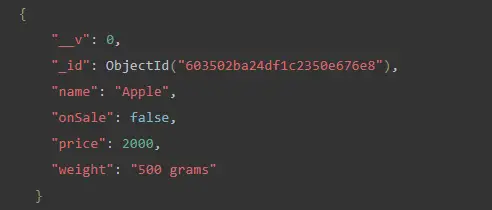The in operator in MongoDB
This MongoDB article will discuss the use of the $in operator in MongoDB.
IN Operator ($in) in MongoDB
MongoDB comes with a number of operators for a range of tasks. The $in operator allows you to precisely locate a document, find()and update()the methods can be used with this operator.
The $in operator compares the value of a field with the values provided in an array to select documents in a collection. If the value of a document field is an array, MongoDB's $in operator will select only those documents where the field contains an array and at least one item matches the provided value.
grammar:
{ field: { $in: [<value1>, <value2>, ... <valuen> ] }
Using the $in operator to match values in MongoDB
Suppose you have a fruit store database management system, and you have a database where you store all the data of your fruit items, such as price, quantity, weight, etc. We will discuss below how to extract the documents that match the result based on a given value.
First, start your MongoDB server and pass the following command to list all databases and use your database.
Order:
show dbs
use data
Let's list all the documents in the collection you have. You can then use the $in operator on them to filter out based on a specific value.
db={
"data": [
{
"_id": ObjectId("6034fd2bf74cfd0438bdb19b"),
"onSale": false,
"name": "Orange",
"price": 500,
"weight": "1 kilograms",
"__v": 0
},
{
"_id": ObjectId("603502ba24df1c2350e676e7"),
"onSale": false,
"name": "Banana",
"price": 350,
"weight": "2 dozen",
"__v": 0
},
{
"_id": ObjectId("603502ba24df1c2350e676e8"),
"onSale": false,
"name": "Apple",
"price": 125,
"weight": "500 grams",
"__v": 0
},
{
"_id": ObjectId("603502ba24df1c2350e676e9"),
"onSale": false,
"name": "Mango",
"price": 300,
"weight": "4 kilograms",
"__v": 0
}
]
}
Updating Documents in MongoDB Using $in Operator
Use the method on a document update()to update the value of certain documents.
db={
"data": [
{
"_id": ObjectId("6034fd2bf74cfd0438bdb19b"),
"onSale": false,
"name": "Orange",
"price": 500,
"weight": "1 kilograms",
"__v": 0
},
{
"_id": ObjectId("603502ba24df1c2350e676e7"),
"onSale": false,
"name": "Banana",
"price": 350,
"weight": "2 dozen",
"__v": 0
},
{
"_id": ObjectId("603502ba24df1c2350e676e8"),
"onSale": false,
"name": "Apple",
"price": 125,
"weight": "500 grams",
"__v": 0
},
{
"_id": ObjectId("603502ba24df1c2350e676e9"),
"onSale": false,
"name": "Mango",
"price": 300,
"weight": "4 kilograms",
"__v": 0
}
]
}
If you want to change the price of the fruit "Apple". You can change the price of "Apple" to "200" through this query.
Query:
db.data.update({
name: {
$in: [
"Apple"
]
}
},
{
$set: {
price: 200
}
})
After using find()the method, you will get the following result. update()The price of "Apple" is updated from 125 to 200 using the $in operator in the method.
Output:

Through this MongoDB tutorial article, you have learned what the $in operator is, how to use the $in operator to match values in a database collection, and how to update or edit a given collection in the database.
For reprinting, please send an email to 1244347461@qq.com for approval. After obtaining the author's consent, kindly include the source as a link.
Related Articles
$ne operator in MongoDB
Publish Date:2025/04/11 Views:84 Category:MongoDB
-
This article will discuss how the $ne operator works in MongoDB. In addition, we will list its differences from the $not operator. $ne operator in MongoDB $ne is an operator in MongoDB that stands for not equal to. This will compare the val
MongoDB $Set Operator
Publish Date:2025/04/11 Views:159 Category:MongoDB
-
With the help of this article, you will learn how to use $set the operator to partially update objects in MongoDB so that the new object overlaps/merges with the existing object. The $set operator replaces the value of a field with a given
Difference between $push and $addToSet in MongoDB
Publish Date:2025/04/11 Views:63 Category:MongoDB
-
This article explains the operators in MongoDB. What is the purpose of $push and $addToSet operators. Furthermore, the difference between these two operators is given in the code snippet. This article discusses the following topics. Operato
Sort a collection by date in MongoDB
Publish Date:2025/04/11 Views:64 Category:MongoDB
-
In this MongoDB tutorial, the problem of sorting a collection in MongoDB is discussed. The different ways to sort a collection in the database are briefly explained. Using sort() function in MongoDB This problem is solved using the MongoDB
Counting records in MongoDB
Publish Date:2025/04/11 Views:146 Category:MongoDB
-
This article discusses operators in MongoDB, aggregation operators, and different ways to calculate the total number of records. Operations in MongoDB CRUD operations are a user interface concept that allows users to browse, search, and cha
Pretty printing in MongoDB
Publish Date:2025/04/11 Views:150 Category:MongoDB
-
This article will discuss how to use pretty printing in MongoDB to display formatted results. Pretty printing in MongoDB A cursor is an object that allows programmers in the Mongo world to iterate over documents in a Mongo collection. Altho
MongoDB Adding Elements to an Array
Publish Date:2025/04/11 Views:136 Category:MongoDB
-
This article will cover the various ways to add to an array in MongoDB. Adding to an array in MongoDB Use the $push operator to add values to an array The $push operator is one of the various array update operators provided by MongoDB
MongoDB Search by ID
Publish Date:2025/04/11 Views:131 Category:MongoDB
-
The following article provides an overview of MongoDB find by Id() method. MongoDB provides a find by Id() function which can retrieve documents matching a user id. To use search by Id() in MongoDB, you need to use the find() function. If n
MongoDB starts with a query
Publish Date:2025/04/10 Views:195 Category:MongoDB
-
In this MongoDB article, users will learn how to start queries using $regex. It provides regular expression functionality for pattern matching strings in queries. MongoDB starts querying using $regex If you want to use $regex , use one of t

